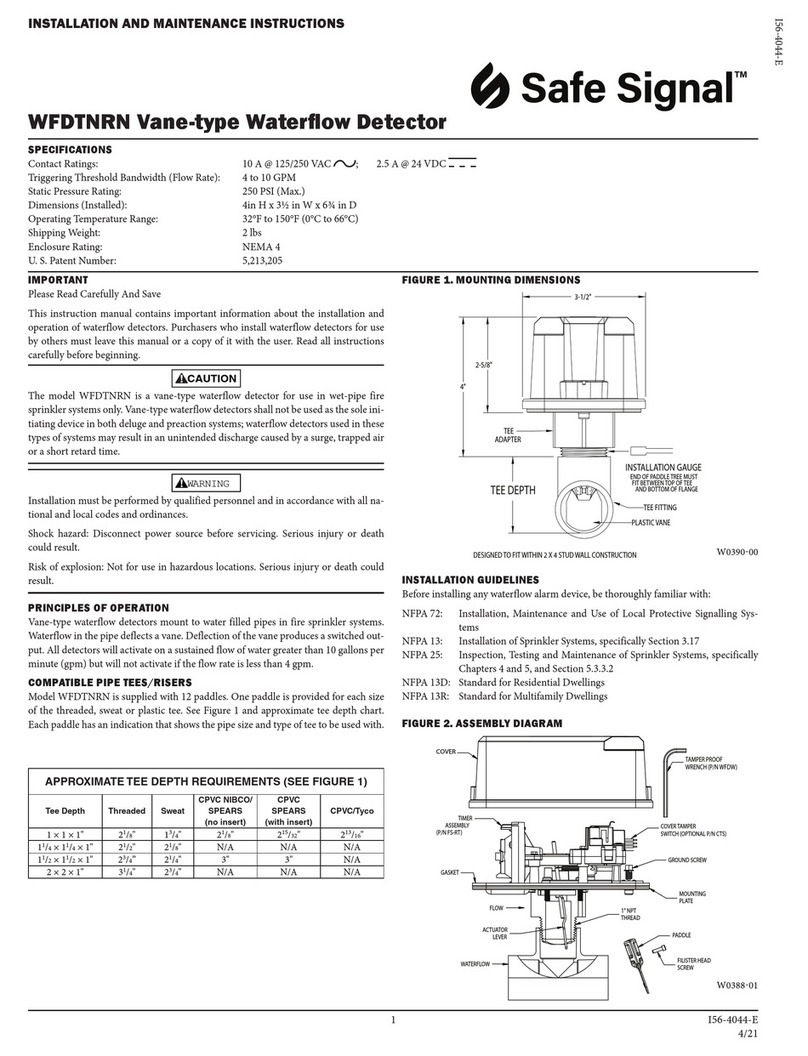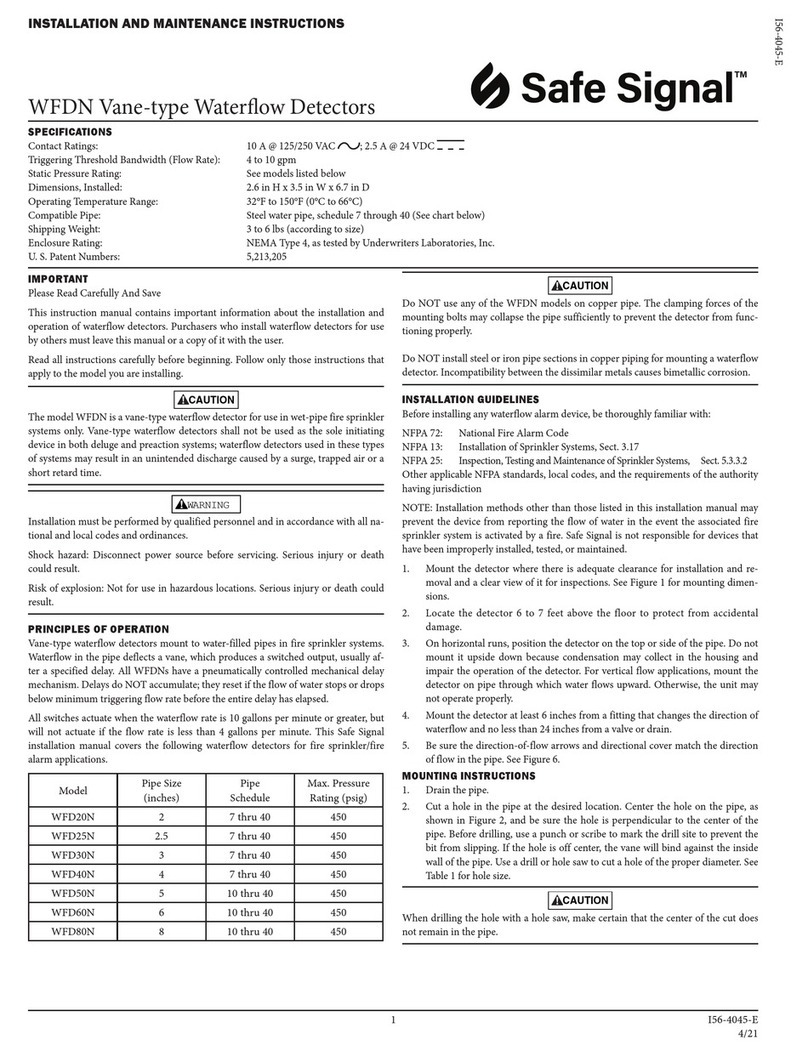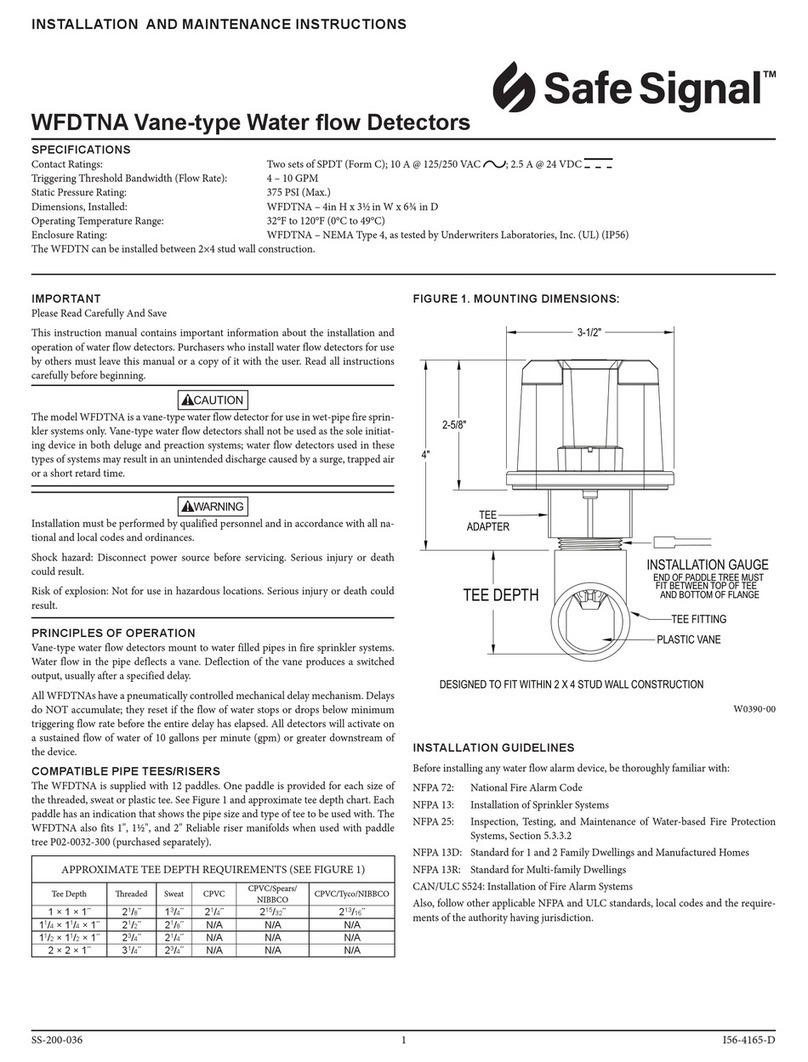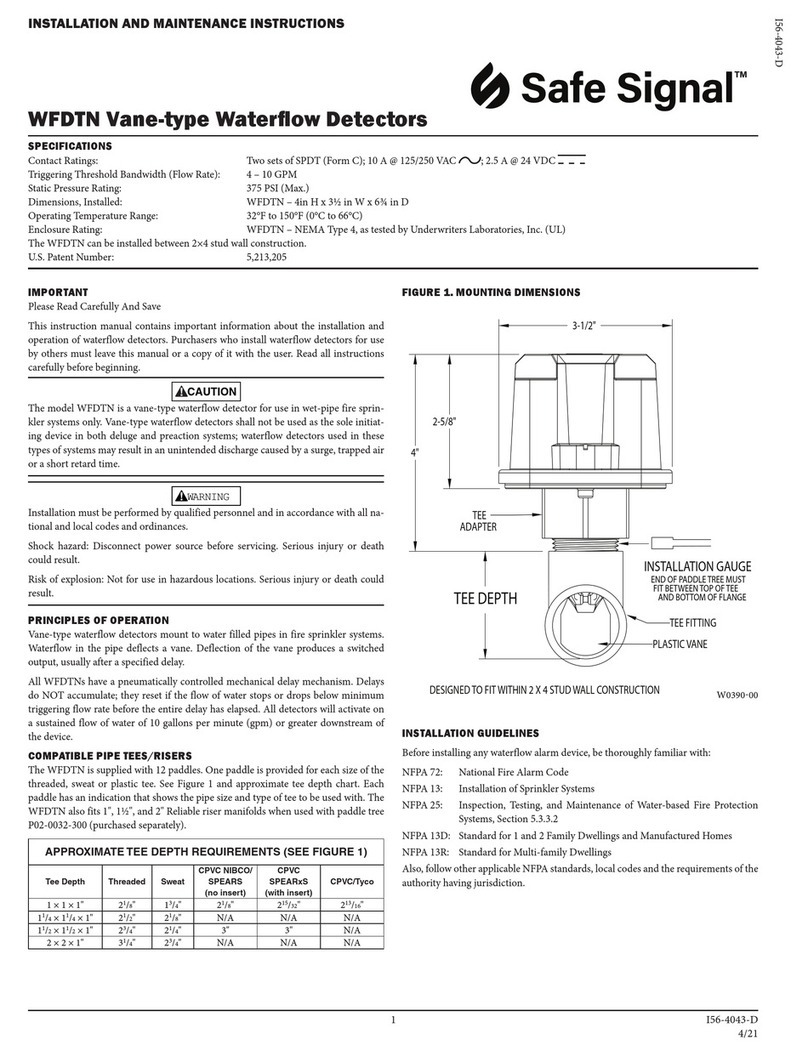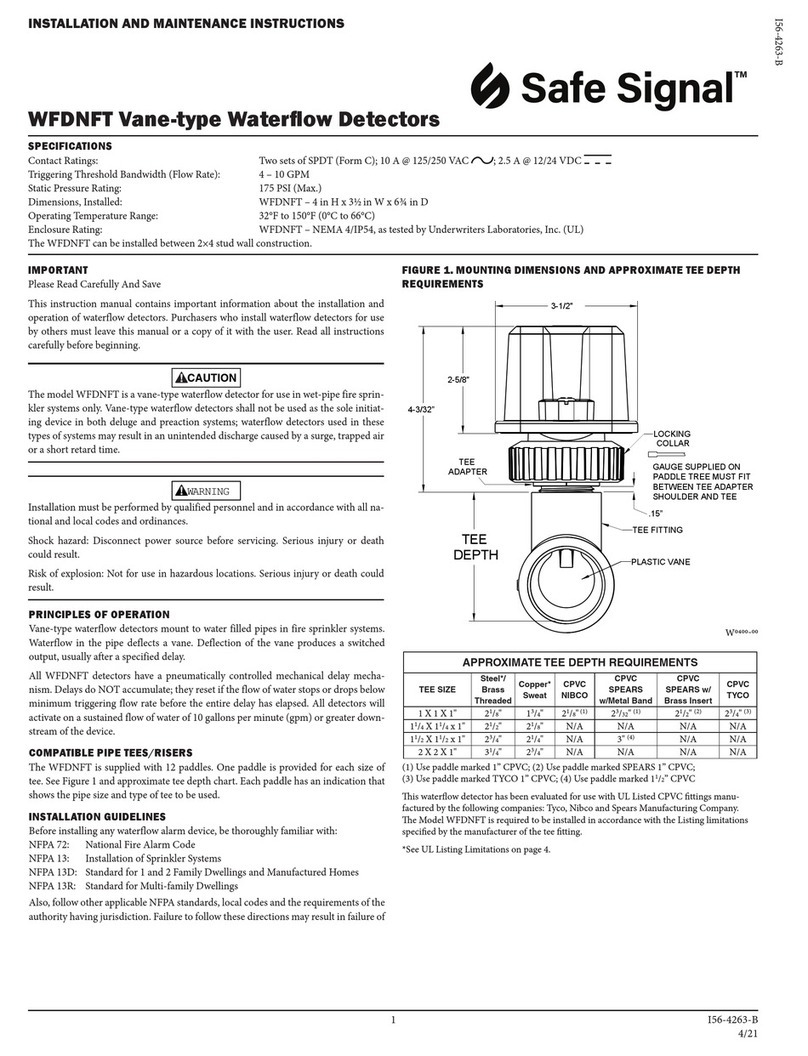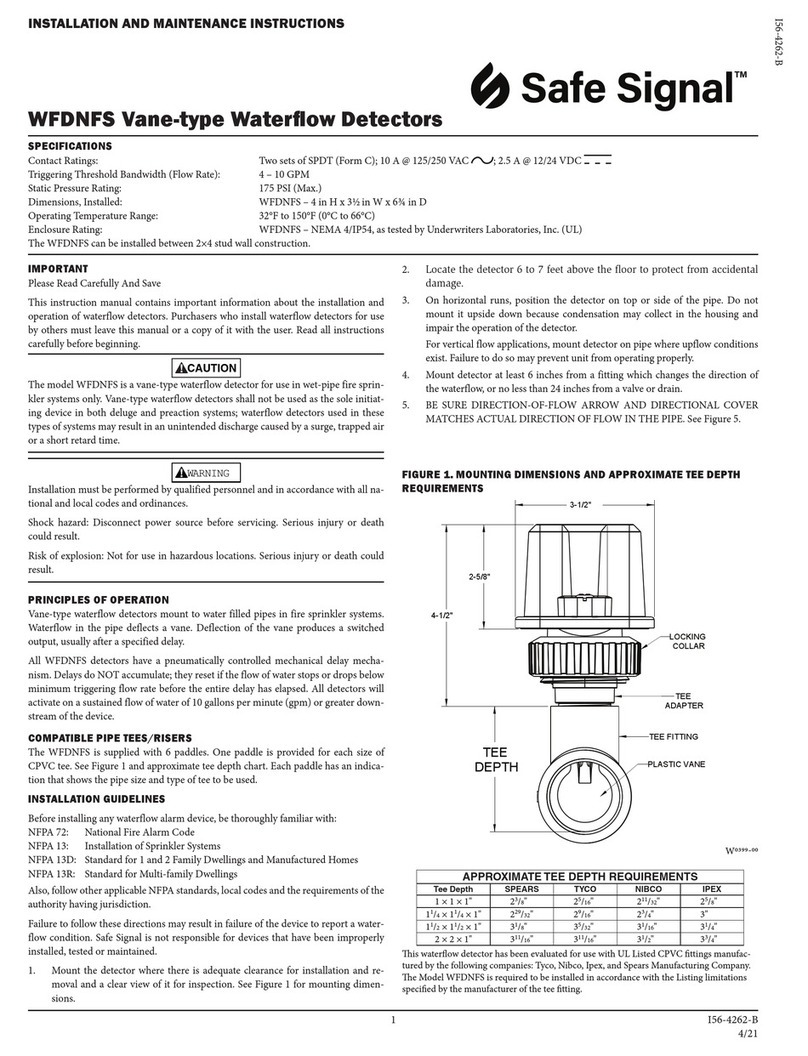
WFDEN Vane-type Waterow Detector
INSTALLATION AND MAINTENANCE INSTRUCTIONS
IMPORTANT
Please Read Carefully And Save
This instruction manual contains important information about the installation and
operation of waterflow detectors. Purchasers who install waterflow detectors for use
by others must leave this manual or a copy of it with the user.
Read all instructions carefully before beginning. Follow only those instructions that
apply to the model you are installing.
The model WFDEN is a vane-type waterflow detector for use in wet-pipe fire sprin-
kler systems only. Vane-type waterflow detectors shall not be used as the sole initiat-
ing device in both deluge and preaction systems; waterflow detectors used in these
types of systems may result in an unintended discharge caused by a surge, trapped air
or a short retard time.
Installation must be performed by qualified personnel and in accordance with all na-
tional and local codes and ordinances.
Shock hazard: Disconnect power source before servicing. Serious injury or death
could result.
Risk of explosion: Not for use in hazardous locations. Serious injury or death could
result.
PRINCIPLES OF OPERATION
Vane-type waterflow detectors mount to water-filled pipes in fire sprinkler systems.
Waterflow in the pipe deflects a vane, which produces a switched output, usually af-
ter a specified delay. All WFDENs have a pneumatically controlled mechanical delay
mechanism. Delays do NOT accumulate; they reset if the flow of water stops or drops
below minimum triggering flow rate before the entire delay has elapsed.
All switches actuate on a sustained flow of water greater than the maximum specified
in Table 1, but will not activate if the flow rate is less than the minimum specified in
Table 1.
This Safe Signal installation manual covers the following waterflow detectors for fire
sprinkler/fire alarm applications.
TABLE 1.
VdS LPCB
Model
Number
DN Ref.
Pipe Size
mm (in)
Nominal
Pipe O.D.
(mm)
Wall
Thickness
(mm)
Triggering
Flow Rate
(liters/min)
Nominal
Pipe O.D.
(mm)
Wall Thickness
(mm)
WFD20EN 50 (2) 60.3 2.3/2.9 47 60.3 3.6
WFD25EN 66 (2,5) 76.1 2.6/2.9 49 76.0 3.6
WFD30EN 80 (3) 88.9 2.9/3.2 47 88.8 4.0
WFD40EN 100 (4) 114.3 3.2/3.6 53 114.1 4.5
WFD60EN 150 (6) 168.3 4.0/4.5 55 165.1 5.0
WFD80EN 200 (8) 219.1 4.5/5.9 64 219.1 6.3
SPECIFICATIONS
Contact Ratings: 10 A @ 125/250 VAC~; 2.5 A @ 24 VDC EC–certificate Number: 0786-CPR-40299
Triggering Flow Rate: Refer to Table 1 EN12259–5
Static Pressure Rating (maximum): 17.25 bar (250 psi) (1725 KPa); 16 bar (VdS) VDS Certificate Number: G 415003
Operating Temperature Ranges: 0°C to 68°C (32°F to 155°F)
Compatible Pipe: Steel Water Pipe (Refer to Table 1)
Shipping Weight: 3 to 6 lbs (according to size)
Enclosure Rating: Nema4/IP54
STEEL PIPE COMPATIBILITY
Do not use any of the WFDEN models on copper pipe. The clamping forces of the
mounting bolts may collapse the pipe sufficiently to prevent the detector from func-
tioning properly.
Do NOT install steel or iron pipe sections in copper piping for mounting a waterflow
detector. Incompatibility between the dissimilar metals causes bimetallic corrosion.
INSTALLATION GUIDELINES
Before installing any waterflow alarm device, be thoroughly familiar with national codes
of practice and the requirements of the authority having jurisdiction.
NOTE: Installation methods other than those listed in this installation manual may
prevent the device from reporting the flow of water in the event the associated fire
sprinkler system is activated by a fire. Safe Signal is not responsible for devices that
have been improperly installed, tested or maintained.
1. Mount the detector where there is adequate clearance for installation and re-
moval and a clear view of it for inspections. See Figure 1 for mounting dimen-
sions.
2. Locate the unit 1.8 – 2.1 meters above the floor to protect from accidental dam-
age.
3. On horizontal runs, the detector must be positioned on the top of the pipe, not
on the side or below. Do not mount it upside down because condensation may
collect in the housing and impair the operation of the detector. For vertical flow
applications, mount detector on pipe through which water flows upward. Oth-
erwise, the unit may not operate properly.
4. Mount detector at least 15 cm from a fitting that changes the direction of the
waterflow, or no closer than 61 cm from a valve or drain.
5. BE SURE DIRECTION-OF-FLOW ARROW AND DIRECTIONAL COVER
MATCHES ACTUAL DIRECTION OF FLOW IN THE PIPE. See Figure 6.
MOUNTING INSTRUCTIONS
1. Drain the pipe.
2. Cut a hole in the pipe in the desired location. Center the hole on the pipe as
shown in Figure 2, and be sure the hole is perpendicular to the center of the
pipe. Before drilling, use a punch or scribe to mark the drill site to prevent the
bit from slipping. If the hole is off center, the vane will bind against the inside
wall of the pipe. Use a drill or hole saw to cut a hole of the proper diameter. See
Table 2 for hole size.
When drilling the hole with a hole saw, make certain that center of hole saw cut does
not remain in pipe.
I56-4051-F
1 I56-4051-F
4/21






